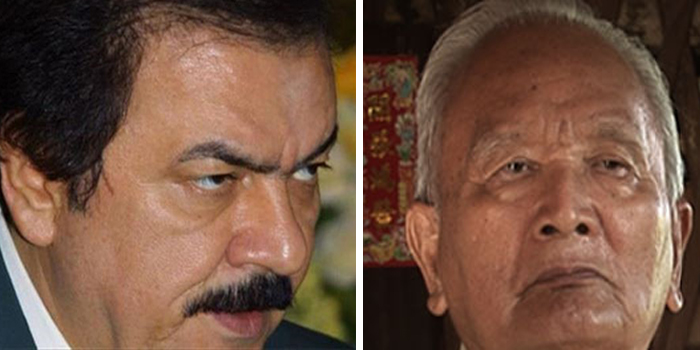About two decades ago when Elizabeth Rubin titled his article on the Mujahedin-e Khalq as “the Cult of Rajavi” and published it in the New York Times Magazine, she quoted the Iranian public opinion at the end of the article with a phrase that was actually warning and distressing: “the Rajavis, given the chance, would have been the Pol Pot of Iran.”
“Pol Pot of Iran” is also a title that Paul Sheldon Foote, the American university professor, has always used to address Massoud Rajavi, the disappeared leader of the MEK. “During the American hostage crisis, the MEK participated and called for the executions of the Americans,” he writes. “Rajavi is anti-American, anti-imperialist, and anti-capitalist. His aim is to become the Pol Pot of Iran, even if the MEK must become a tool of the American government to achieve his aim.”
Why such a comparison?

Raajvi; Polpot of Iran
Rajavi vs Pol Pot
Pol Pot is notoriously known as one of the most violent dictators in the world history. Pol Pot was a Cambodian revolutionary, dictator, and politician who ruled Cambodia as Prime Minister of Democratic Kampuchea between 1976 and 1979. During that time, an estimated 1.5 to 2 million Cambodians died of starvation, execution, disease or overwork. One detention center, S-21, was so notorious that only seven of the roughly 20,000 people imprisoned there are known to have survived.
Massoud Rajavi founded his cult of personality on the dead bodies of thousands of civilians who were killed by his bombing teams. The most horrific acts of his cult were the operations he launched against Iraqi Kurds and Shiites and Iranian soldiers in Forough Jbvidan.
S21 vs Eskan
Let us compare the Pol Pot era in Cambodia with the rule of Massoud Rajavi’s cult of personality in Camp Ashraf, Iraq during the 1980s and the 1990s.
Around one third of the rank and file of the MEK were accused of being agents of the Iranian government and so disloyal to the group’s cause. They were imprisoned, jailed in solitary confinement, tortured and even killed under torture just because they had asked to leave the group or had dared to criticize the leader. Ghorban Ali Torabi and Parviz Ahmadi are two of the MEK victims who were killed under torture by the organization that they had been serving for years.
A large number of former members of the group have testified about the tortures they endured in the prison of Camp Ashraf called Eskan. (The violence the MEK leaders committed against their own members should be considered together with the terrorist acts against the Iranian civilians and officials.)
Family life in the MEK and in Khmer Rouge
In 1988, Massoud Rajavi ordered members to divorce their spouses under the pretext that family life and sex life would distract the rank and file from their struggle against Iran. A year later, over 700 children of the Mujahedin were separated from their parents and were smuggled to European countries, under the order of Massoud Rajavi. About 300 of these children were later dispatched back to the MEK’s camp in Iraq in their teen years. They were recruited in the MEK’s army the so-called National Liberation Army. These child soldiers were given military uniforms, arms and military trainings in order to be prepared to invade Iran.
A decade earlier, you could see the same pattern of family life in Cambodia ruled by Khmer rouge. In order to enforce loyalty to the state, the Khmer Rouge broke peoples’ ties to religion and family. All political and civil rights were abolished. Formal education ceased and from January 1977, all children from age of eight were separated from their parents and placed in labour camps, which taught them that the state was their true parents. For the Khmer Rouge, children were central to the revolution as they believed they could be easily moulded, conditioned and indoctrinated. They could be taught to obey orders, become soldiers and kill enemies. Children were taught to believe that anyone not conforming to the Khmer laws were corrupt enemies.
Forced marriage before forced divorces
According to Pol Pot’s regulations, people were not allowed to choose their own marriage partners. They could not leave their given place of work or even select the clothes that they would wear. It should be noted that the Cult of Rajavi went further to force members to marry the ideological comrade that the group had selected for them before the later ruling of Massoud Rajavi that forced members to divorce and maintain a mandatory lifelong celibacy.
No one is married in the MEK’s camp in Albania right now. The rank and file of the MEK had to were military uniforms when they were settled in Camp Ashraf Iraq. After the group’s disarmament by the US army, their clothing was still regulated by the organization.
Today, MEK female member have to wear hijab. They are not allowed to wear tight or short clothes. However, the dress code is strict for both sexes in the group. Male members are not allowed to wear shorts or T-shirts in the world of 2022!
There are definitely a large number of more common personality and behavior traits between Pol Pot and Rajavi that can be taken into consideration to prove that Rajavi is ruling a modern slavery in the heart of Europe in Albanian territory very similar to the bloody dictatorship of Pol Pot that destroyed Cambodia. It may seem bizarre but must be just believed by the world’s human rights bodies and activists.
By Mazda Parsi
